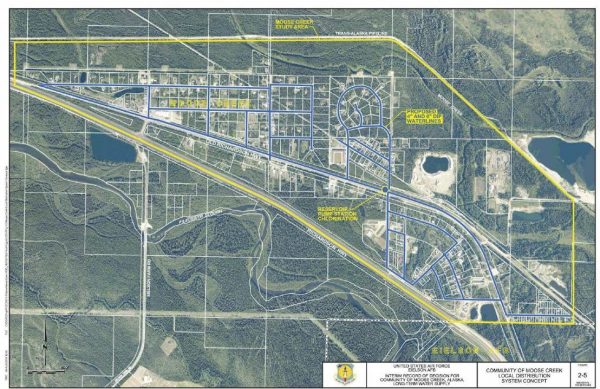
Work will begin next month on a $30 million project to extend North Pole’s municipal water system to Moose Creek, where residents can no longer use their wells because the groundwater’s been contaminated by PFAS, a chemical compound that came from Eielson Air Force Base.
North Pole Mayor Mike Welch said the City Council considered four bidders for the water-system expansion project in a Jan. 30 meeting, before choosing HC Contractors.
“We actually had a special meeting just so we wouldn’t have to wait ‘til February 3rd, because time was of the essence,” he said. “They wanted to get started on this.”
Read our continuing coverage of PFAS contamination and remediation across Alaska
Welch said work will begin next month and be completed by fall of next year. So far, he said, about 185 people and a few businesses around Moose Creek have signed up to be connected to the North Pole water system.
“That’s a big increase of customers,” he said.
The mayor said those new customers will boost the total number of homes and businesses hooked up to the municipal water system to about 1,300. People in Moose Creek can still sign up for the service, he said.
“They need to contact the director of City Services, Mr. Bill Butler,” Welch said.
Related: Extensive new report details cancer-causing PFAS toxins across Alaska
The Pentagon is paying for the project because the substance that contaminated the groundwater beneath Moose Creek came from Eielson Air Force Base. The perflourinated chemical compound called PFAS likely came from the use of firefighting foam at the base.
Welch said the Air Force supported bringing in water from North Pole, in part, because the city has already expanded its system to residents affected by groundwater contamination from another source – the old North Pole Refinery, which leaked an industrial solvent called sulfolane.
“We were the ones that were chosen as the best, capable entity to provide the water because we had the experience taking care of the sulfolane project,” he said.
The mayor said North Pole is more than halfway done with expanding the system to parts of town affected by the sulfolane contamination. He said that project more than doubled the number of municipal water customers, from 540 to about 1,100. All the new customers should help keep the price of city water service stable, he said.
“Economies of scale will help keep the cost consistent – or even go slightly down,” he said.
But Welch said the city may have to add another maintenance worker or two in the years ahead to respond to problems that may occur in the expanded water system, which after the Moose Creek project will include about 51 miles of pipe.
Tim Ellis is a reporter at KUAC in Fairbanks.




